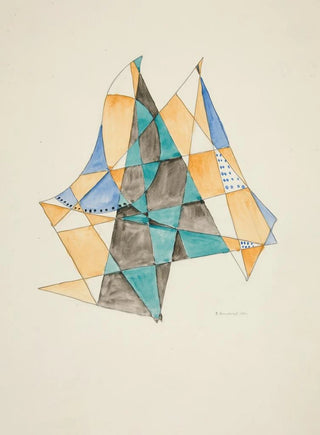Art print Abstraction based on Sails VII - David Kakabadze | Art print


View from behind

Frame (optional)
Art print Abstraction based on Sails VII - David Kakabadze – Captivating introduction
In the vast panorama of abstract art, "Abstraction based on Sails VII" by David Kakabadze stands out for its ability to transcend visual boundaries and evoke deep emotions. This piece, a true ode to modernity, engages in a dialogue between form and color, where each nuance seems to vibrate with inner energy. Kakabadze, an emblematic figure of Georgian art, manages to capture the very essence of light and movement, inviting viewers to an immersive experience that goes beyond mere observation. Far from being a simple representation, this work transports us to a universe where imagination and reality meet, awakening a reflection on our own perception of the world.
Style and uniqueness of the work
The originality of "Abstraction based on Sails VII" lies in its bold approach to abstraction. Kakabadze uses fluid geometric shapes and vibrant colors to create a composition that appears both dynamic and serene. The sails, symbols of travel and escape, float in an undefined space, suggesting a quest for freedom and exploration. The color palette, oscillating between warm and cool tones, gives the piece rare emotional depth. Every element is carefully arranged, demonstrating technical mastery that leaves nothing to chance. This subtle blend of harmony and tension makes this work a captivating piece, capable of inspiring a multitude of interpretations. Thus, Kakabadze's work does not merely please the eye; it engages the mind and heart in a poetic dance.
The artist and his influence
David Kakabadze, born in Georgia in 1889, is often considered one of the pioneers of abstract art in his country. His artistic journey is marked by a constant search for new forms of expression, influenced as much by Cubism as by Constructivism. Kakabadze successfully integrated these avant-garde movements into his own artistic language, creating a work that resonates with the aspirations of his era. His unique vision, blending tradition and modernity, has had a significant impact on

Matte finish

View from behind

Frame (optional)
Art print Abstraction based on Sails VII - David Kakabadze – Captivating introduction
In the vast panorama of abstract art, "Abstraction based on Sails VII" by David Kakabadze stands out for its ability to transcend visual boundaries and evoke deep emotions. This piece, a true ode to modernity, engages in a dialogue between form and color, where each nuance seems to vibrate with inner energy. Kakabadze, an emblematic figure of Georgian art, manages to capture the very essence of light and movement, inviting viewers to an immersive experience that goes beyond mere observation. Far from being a simple representation, this work transports us to a universe where imagination and reality meet, awakening a reflection on our own perception of the world.
Style and uniqueness of the work
The originality of "Abstraction based on Sails VII" lies in its bold approach to abstraction. Kakabadze uses fluid geometric shapes and vibrant colors to create a composition that appears both dynamic and serene. The sails, symbols of travel and escape, float in an undefined space, suggesting a quest for freedom and exploration. The color palette, oscillating between warm and cool tones, gives the piece rare emotional depth. Every element is carefully arranged, demonstrating technical mastery that leaves nothing to chance. This subtle blend of harmony and tension makes this work a captivating piece, capable of inspiring a multitude of interpretations. Thus, Kakabadze's work does not merely please the eye; it engages the mind and heart in a poetic dance.
The artist and his influence
David Kakabadze, born in Georgia in 1889, is often considered one of the pioneers of abstract art in his country. His artistic journey is marked by a constant search for new forms of expression, influenced as much by Cubism as by Constructivism. Kakabadze successfully integrated these avant-garde movements into his own artistic language, creating a work that resonates with the aspirations of his era. His unique vision, blending tradition and modernity, has had a significant impact on
12,34 €






